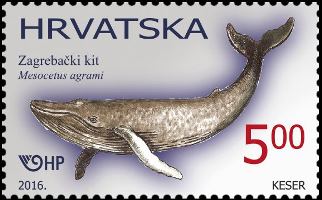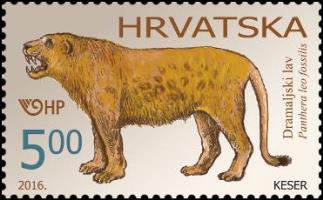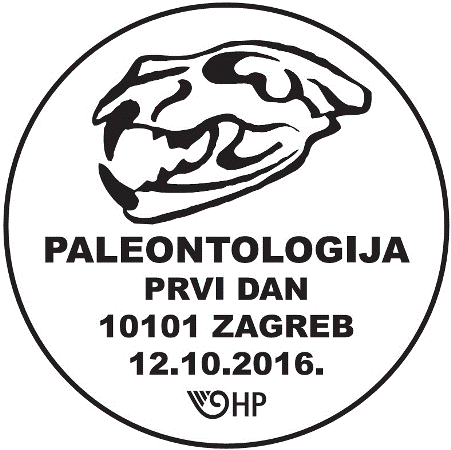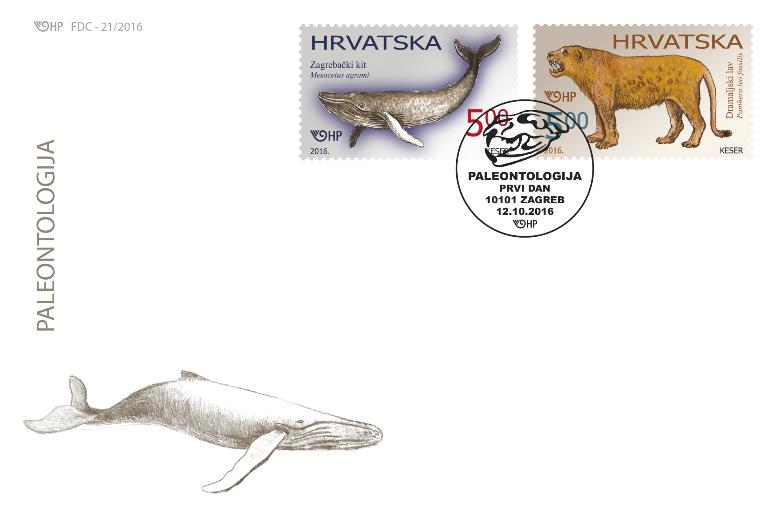Am 12.10.2016 erschienen folgende Marken:

Der Wal von Zagreb
THE WHALE OF ZAGREB (Mesocetus agrami VAN BENEDEN, 1886) The fossil remains of the whale of Zagreb have been found in marls of the Podsused quarry which date from the Sarmatian, about 13 million years ago. The remains of the whale which were lying in the depot of then National Museum were sent by Gjuro Pilar to the Professor Pierre-Joseph van Beneden (1809 – 1894) – Belgian zoologist and palaeontologist, for determination. These were the bones of the back part of skull, various vertebrae, a part of jaw and auditory system and rib fragments – in total 11 bones. In his work “Une baleine fossil de Croatie, appartenant au genre Mesocete” from 1884 Van Beneden attributed these bones to the remains of the whale from the genus Mesocetus and since at that time it was an unknown species he named it after Zagreb - Mesocetus agrami. So our whale got his name which in translation means Mesocet of Zagreb or the whale of Zagreb. Some time later Dragutin Gorjanović-Kramberger, a famous Croatian palaeontologist published his work O fosilnih cetaceih Hrvatske i Kranjske (On Fossil Cetaceans of Croatia and Carniola, 1892) in which he described all then known paleontological sites of whales in Croatia and Slovenia. He described again the species Mesocetus agrami since from the time of Van Beneden's description some new bones had been found which Gorjanović attributed to that same exemplar – the right upper arm bone, a part of the lower arm bone and the lower and upper jaw. The whale of Zagreb, Mesocetus agrami, belongs to the extinguished genus of whales - Mesocetus, to the family of Balaenopteridae, suborder Mysticeti – Baleen whales (whalebone whales). Today's whales from this family are among the biggest animals on Earth and some can reach the length of up to about thirty metres. On the basis of fossil remains – back part of the skull, upper jaw, incomplete lower jaw, right upper arm bone, part of the right lower arm bone and thirteen vertebrae it was concluded that the whale of Zagreb was about 6 metres long, which suggests that we are dealing here with a younger animal. According to the structure of jaw it can be determined that the whale most probably fed on plankton and small fishes. Dražen Japundžić

Der Löwe von Dramalj
THE LION OF DRAMALJ - Panthera leo fossilis (REICHENAU, 1906) In the cave Vrtare male near Dramalj at the depth of about thirty metres, rich material has been extracted and collected from the cave sediment, consisting of fossil bones. Collected fossil remains relate to Pleistocene fauna of big mammals from the family Canidae, Ursidae, Felidae, Hyaenidae, Leporidae, Suidae, Cervidae, Bovidae, Rhinocerotidae, Equidae and Elephantidae. Among numerous and very well preserved bones prominent are the fossil remains of lions and bears. The particularity of this paleontological site is the fossil remains of cave lions, an extinguished species which lived in Europe and Asia during Middle Pleistocene. The material examined so far refers to fossil bones of three grown-up males and one female. Morphometric characteristics of teeth and other skeleton elements classify the lions of Dramalj into the Middle Pleistocene subspecies Panthera leo fossilis. With the body length of more than 240 cm, which is 50 cm more than the length of today's African lions, this subspecies represents the biggest cat that has ever lived on the territories of Europe and Asia. The lions of Dramalj are among the biggest ever found fossils of European lions. The confirmation of the Middle Pleistocene age is the result of the absolute dating method with uranium isotopes applied on the sample of fossil lion bone, with the preliminary age result of about 300,000 years. It is supposed that the cave Vrtare male represents only remains from the once much vaster speleological object whose entrance at the time of Middle Pleistocene probably functioned as a natural trap into which the animals were caught and died, to which fact the huge accumulation of very well preserved fossil bones is due. The cave Vrtare male is an exceptionally valuable palaeontological site, actually the most important one as concerns Middle Pleistocene mammals in Croatia. Dražen Japundžić
Der Ersttagsstempel zeigt den skelettierten Kopf des Löwen

FDC

Quelle: Post Kroatien
